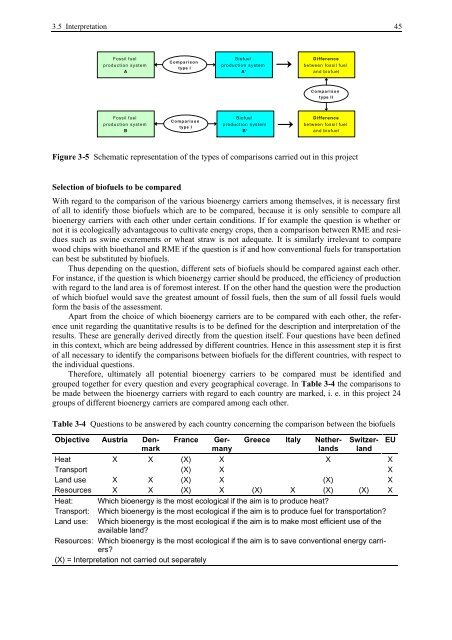BIOENERGY FOR EUROPE: WHICH ONES FIT BEST?
BIOENERGY FOR EUROPE: WHICH ONES FIT BEST?
BIOENERGY FOR EUROPE: WHICH ONES FIT BEST?
Create successful ePaper yourself
Turn your PDF publications into a flip-book with our unique Google optimized e-Paper software.
3.5 Interpretation 45<br />
Fossil fuel<br />
production system<br />
A<br />
Fossil fuel<br />
production system<br />
B<br />
Comparison<br />
type I<br />
Comparison<br />
type I<br />
Biofuel<br />
production system<br />
A‘<br />
Biofuel<br />
production system<br />
B‘<br />
Difference<br />
between fossil fuel<br />
and biofuel<br />
Comparison<br />
type II<br />
Difference<br />
between fossil fuel<br />
and biofuel<br />
Figure 3-5 Schematic representation of the types of comparisons carried out in this project<br />
Selection of biofuels to be compared<br />
With regard to the comparison of the various bioenergy carriers among themselves, it is necessary first<br />
of all to identify those biofuels which are to be compared, because it is only sensible to compare all<br />
bioenergy carriers with each other under certain conditions. If for example the question is whether or<br />
not it is ecologically advantageous to cultivate energy crops, then a comparison between RME and residues<br />
such as swine excrements or wheat straw is not adequate. It is similarly irrelevant to compare<br />
wood chips with bioethanol and RME if the question is if and how conventional fuels for transportation<br />
can best be substituted by biofuels.<br />
Thus depending on the question, different sets of biofuels should be compared against each other.<br />
For instance, if the question is which bioenergy carrier should be produced, the efficiency of production<br />
with regard to the land area is of foremost interest. If on the other hand the question were the production<br />
of which biofuel would save the greatest amount of fossil fuels, then the sum of all fossil fuels would<br />
form the basis of the assessment.<br />
Apart from the choice of which bioenergy carriers are to be compared with each other, the reference<br />
unit regarding the quantitative results is to be defined for the description and interpretation of the<br />
results. These are generally derived directly from the question itself. Four questions have been defined<br />
in this context, which are being addressed by different countries. Hence in this assessment step it is first<br />
of all necessary to identify the comparisons between biofuels for the different countries, with respect to<br />
the individual questions.<br />
Therefore, ultimately all potential bioenergy carriers to be compared must be identified and<br />
grouped together for every question and every geographical coverage. In Table 3-4 the comparisons to<br />
be made between the bioenergy carriers with regard to each country are marked, i. e. in this project 24<br />
groups of different bioenergy carriers are compared among each other.<br />
Table 3-4 Questions to be answered by each country concerning the comparison between the biofuels<br />
Objective Austria Denmark<br />
France Germany<br />
Greece Italy Netherlands <br />
Switzerland<br />
Heat X X (X) X X X<br />
Transport (X) X X<br />
Land use X X (X) X (X) X<br />
Resources X X (X) X (X) X (X) (X) X<br />
Heat: Which bioenergy is the most ecological if the aim is to produce heat?<br />
Transport: Which bioenergy is the most ecological if the aim is to produce fuel for transportation?<br />
Land use: Which bioenergy is the most ecological if the aim is to make most efficient use of the<br />
available land?<br />
Resources: Which bioenergy is the most ecological if the aim is to save conventional energy carriers?<br />
(X) = Interpretation not carried out separately<br />
EU

















